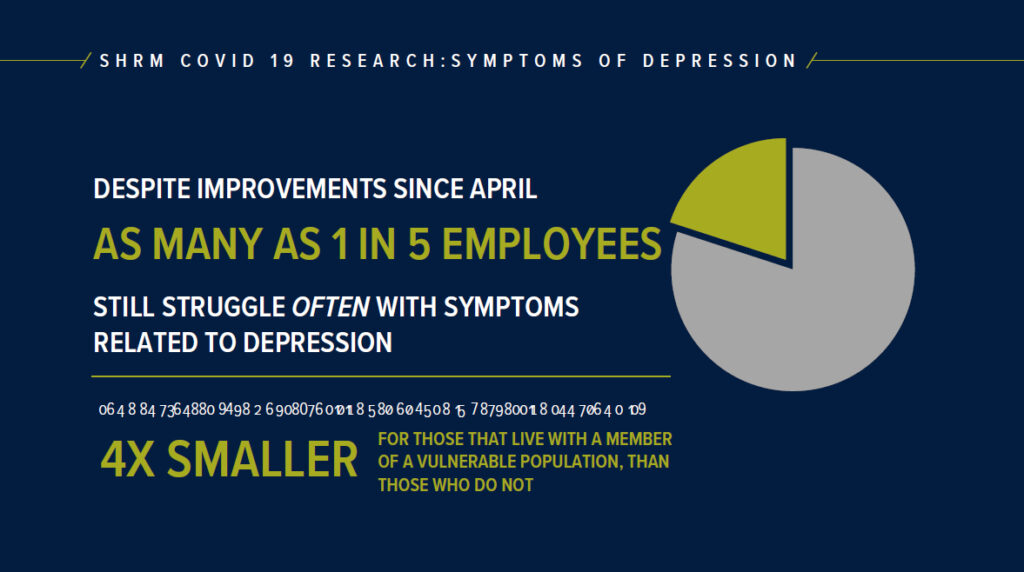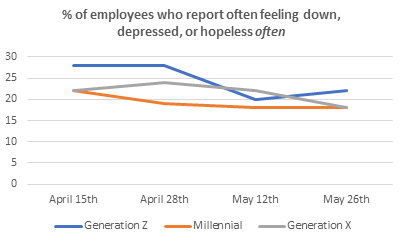By Casey Sword
A global pandemic, a recession, and a mental health crisis? It’s not completely out of the question and it wasn’t before COVID-19 either.
Data from Mental Health America (MHA) painted a grim picture of mental health in the United States before COVID—one in which the prevalence of mental health conditions increased significantly for our nation’s youth, and millions of adults and children experiencing mental health conditions were not getting the help they desperately needed.
The current economic downturn has likely exacerbated these alarming trends and will almost certainly have long-lasting effects on mental health.
This unfortunate reality is also felt by the U.S. workforce, particularly in the early months of COVID-19 as states shut down and employees were forced to adjust to new ways of work. To identify the toll COVID-19 was taking on employee mental health, SHRM collected longitudinal data across the same group of U.S. employees from April to late May 2020. In April, SHRM Research found that 22-35 percent of employees reported experiencing symptoms of depression often, and as many as 2 in 3 experienced depressive symptoms at least sometimes during COVID-19. The symptoms included feeling tired or having little energy, feeling bad about themselves, feeling down, depressed, or hopeless, having little interest or pleasure in doing things, and having trouble concentrating.
In the last few months, we have witnessed steady improvements in unemployment figures, job gains, and even a reduction in the number of employees who feel as though COVID-19 is threatening certain aspects of their jobs. More good news is that we are witnessing a slight declining trend in the number of employees reporting they often experience symptoms related to depression. This suggests that employees have begun to adapt or find ways to cope with their circumstances. However, there are still many employees in the U.S. who continue to experience furloughs, lay-offs and uncertainty around job security, finances, schooling, and so much more. And in late May 2020, SHRM found that as many as 1 in 5 employees were still struggling often with symptoms related to depression.

Taking other demographic factors into account, SHRM found that some employees are faring worse than others. For example, individuals who do not live with a member of a vulnerable population were four times more likely to report improvements in their depressive symptoms than individuals who do live with someone in this population. Additionally, out of the 1 in 4 employees who reported often feeling bad about themselves or that they were a failure, nearly 2 in 3 were individuals who lived with at least one member of a vulnerable population. While there have been adaptations to a new working world, those who remain the most at-risk continue to confront these anxieties each day.
There are also differences across generations: Generation Z was 4 percent more likely to feel down, depressed, or hopeless often than other generational counterparts. They were also the most likely to report these symptoms at the beginning of the study in April (See Figure 2).
Figure 2 (Source: SHRM COVID-19 Research: Mental Health):

Despite the unpredictable nature of work right now, employees continue to push through. Some have been working in-person since the beginning of COVID-19, some have been phased in, some are still working remotely for the time being, and others may never return to their worksites again. For those working remotely, the lines between work and play are often blurred as employees are logging more hours online. For those working onsite, they may risk their own health as well as the health of those that they live with. Each situation proves difficult to navigate, but across all groups, SHRM found that over 2 in 5 employees have consistently reported feeling burned out, drained, or exhausted from work (41-45 percent).
Feelings of burnout or exhaustion from work can be caused by many internal and external factors. That doesn’t necessarily mean that organizations are always at fault, but it does mean that organizations have a role to play in prioritizing mental health—for the sake of both employees and the company. There are lots of ways that employers can get started if they haven’t already.
The most important thing that employers can do is prioritize mental health and wellness offerings in their benefits portfolio and policies. Employees want to know that their company is on their side, especially when times are hard. This is a very actionable way to prove employers’ investment in their employees.
The second most important thing employers can do is communicate these offerings to employees and constantly advocate for them. SHRM Research found that only 28 percent of employees said that they wanted access to a mental health professional. Of those who said they didn’t want or need access to mental health professionals, 35 percent said they thought how they were coping was good enough, 34 percent said that how they were feeling wasn’t severe enough to talk to someone, and 6 percent said they didn’t have the resources (time, money, and access). While most employees said they didn’t need or want to speak to a mental health professional, there are many other ways that organizations can support employees’ mental health and well-being. And everyone can benefit from these services—it’s important that this is clearly communicated to employees.
Employee Assistance Programs
Towards the beginning of the pandemic, one-third of employers saw an increase in requests for information about Employee Assistance Programs (EAPs). EAPs have traditionally assisted employees with substance abuse, but now most include clinical counseling on a broader range of issues like relationship challenges, financial or legal problems, well-being matters, and traumatic events. For employees juggling work and caregiving responsibilities, EAPs also include childcare and eldercare referrals. These benefits are usually made available to employees’ families, too. However, only 79 percent of employers surveyed in the SHRM 2019 Employee Benefits report offered an EAP to their employees. Employers should consider offering or expanding this offering, as it might save on insurance costs in the long run and lead to positive impacts on employees’ mental health well-being.
Flexible Work
SHRM Research found that during COVID-19, employees who do not telework feel drained from their workday and used up at the end of the day at higher rates than those who telework. Another SHRM study during COVID-19 found that 70 percent of American workers would prefer working remotely either full-time or part-time if they had the choice. As organizations continue to navigate the pandemic and recession, they should consider adopting broader or more flexible work policies if they can—at least on a case-by-case basis. Some of the flexible work benefits might include flexible scheduling, compressed workweeks, job sharing options, and part-time work, among others. If flexible work does not negatively impact productivity, organizations should consider how these arrangements might reduce the stress and burden many employees are carrying, particularly vulnerable employees or those with caregiving responsibilities.
Wellness Benefits
For some organizations, offering wellness benefits might seem lower on the list of priorities. However, more and more employers are offering services that focus on relaxation and stress relief, meditation, mindfulness, contemplative programs, and even personal or life coaching. Not to mention that these could prove useful in improving employee mental health, behaviors, and coping mechanisms. For organizations that are not currently offering fitness-related stipends or benefits due to COVID-19, there are plenty of other benefits to choose from that would be just as impactful.
Encourage employees to take their leave
Taking time off is a crucial way for employees to balance their work and personal lives. With COVID-19 disrupting travel plans for the foreseeable future, many employees are not taking their accrued leave. This is problematic for many reasons, the most important being that employees need time to rest and destress. Organizations, especially managers, should encourage employees to use their vacation days and also follow suit—employees will be discouraged from taking leave if their managers and other team members aren’t.
It’s the little things
Pre-COVID, organizations often engaged employees by hosting holiday parties, celebrating birthdays and company milestones, organizing team retreats, etc. These activities have likely gone virtual, have gone off the radar, or have completely ceased to exist in the past six months. While working in isolation might be preferable for some, it can take a toll on team spirit and communication. Organizations should consider how they can continue to engage their employees with the little things, even if it means celebrating a win with a quick virtual happy hour. Although we are witnessing some improvements in depression-related symptoms, it is clear that many employees are still struggling. It should be in every organization’s interest to prioritize the mental health and well-being of employees, both during and post-COVID. The cost will pay off in the long run.

Casey Sword, Research Specialist
Society for Human Resource Management
casey.sword@shrm.org
shrm.org
